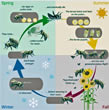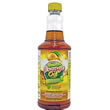Nesting Insects
Magdelena Kutnik (author)
Nesting Insects are a major cause of wood-degradation around the world, and within this category there are several major sub-groups which are distinct and described below:
Carpenter bee (Xylocopa violacea)
Description
Xylocopa violacea, the violet carpenter bee, is a common European and one of the largest bees in Europe. It is also native to Asia.
It is a solitary bee species (it’s not a social insect)
It is not particularly aggressive, and will attack only if forced to
They are important pollinators on open-faced or shallow flowers. And for some species, like the maypop (Passiflora incarnata) and sea rose (Orphium frutescens), they’re the only pollinator.
Like most members of the genus Xylocopa, it makes its nests in dead wood or construction elements, but doesn’t feed on wood
Life cycle
Adults hibernate overwinter in wood in empty nest tunnels and emerge in the spring, usually around April or May.
After mating, the female bores holes and tunnels in dead wood and creates
The eggs are laid within a series of small separate chambers, each of which is sealed with a pollen ball so the emerging larvae can feed upon.
The new adults emerge in late summer then hibernate until the following year
Damage caused to wood
Can attack both softwoods and hardwoods (the softer ones … such as poplar), ideally rotting wood, soft enough to create nesting holes
Their favorite building material is soft, unpainted, and aged wood
Any wooden structure is suitable - arbors, decks, eaves, fascia boards, gates, patio furniture, pergolas, porch ceilings, posts, siding, and window trim
The only external evidence of attack are the entry holes made by the female (round, ~10 mm in diameter)
The galleries follow the grain of the wood in a straight line, sometimes for dozens of cm (galleries up to 50 cm)
The presence of carpenter bees in wood sometimes attracts woodpeckers, which increases the damage to the surface of the wood
How to prevent degradation of wood?
Bee hotels
Citrus oil
Dress exposed wood (paints, stains, varnishes…)
Fill abandoned the holes (with caulk, a dowel, wadded aluminum foil, spray foam insulation, or steel wool)
Mimic a wasp nest
Use traps
Effect of climate change
Climate change has brought this southern European species to the UK. It was first spotted breeding here in 2007 in Leicestershire, but it is still extremely rare, almost certainly because of lack of suitable breeding sites rather than the climate.
The violet carpenter bee used to be very rare in Poland and was believed extinct for 70 years before populations were found to regenerating since 2005 and it is expanding northwards.
With the summer heat, the once-believed-extinct carpenter bee has returned to Poland. Although black and violet, the bee is far from harmful, scientists reassure.
Carpenter ants (Camponotus sp., Lasius sp., Crematogaster scutellaris)
Burrow into wood to make nests (often in moist/starting to decay wood), but do not feed on the wood (predators and scavengers, unable to digesy cellulose)
Commonly nest in dead portions of standing trees, stumps, logs, and sometimes wood in houses
Often found in basements, dark closets, attics, under porches, in crawlspaces, around and under windows, roof eaves, decks ….
Attack both hardwoods and softwoods
Normally do not cause extensive structural damage
The surfaces of the galleries are smooth and are clean, wood shavings are taken out of the home















